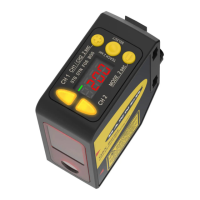July 25, 2023
Q5X With Dual Discrete Outputs And IO-Link Instruction Manual
19
•
•
•
NOTE: Thenumberthatfollowstrconthedisplayindicateswhichchannelisselected.
—HighSpeedAdaptiveTrackingOn
—AdaptiveTrackingOn(default)
—AdaptiveTrackingOff
OFF disables the Adaptive Tracking Algorithm—Preventsthesensorfromadjustingthethresholdsaroundthetaughtrefer
ence surface while the sensor is in dual mode. The sensor will not adapt to or learn any target. Environmental changes may
causethedisplayedvaluetodeviatefrom100P(100%)overtime.Aperiodicreteachofthereferencesurfacemaybere
quiredtorestorethedisplayedvalueto100Pifthisisimportanttotheapplication.
There are some cases in which disabling adaptive tracking is useful. For example, disable adaptive tracking if the target
passesveryslowlythroughthesensingbeam,ifthetargetmightstopwhilepartiallyblockingthebeam,andiftheenviron
mentalconditionsarestable.
ON enables the Adaptive Tracking Algorithm at the standard speed—Recommendedformanyapplicationsdetectinglowcon
trasttargets.Standardadaptivetrackingadjuststhethresholdsaroundslowlychangingbackgroundandenvironmentalcon
ditions. It adjusts the sensor for stable detection when the environment changes due to gradual dust accumulation, machine
vibration, or ambient temperature changes which influence the signal from the reference surface. Standard adaptive tracking
will not easily adapt to or learn slow moving, low contrast targets (for example, clear targets entering and exiting the beam
overapproximately2seconds).
HS enables the Adaptive Tracking Algorithm at high speed—Optionaladaptivetrackingsettingusedwithdualmode.Use
highspeedadaptivetrackingwhenthesignalfromthereferencesurfacechangesquicklyduetounstableenvironmentalcon
ditionsandhighcontrastandhighspeedtargetsarebeingdetected.Highspeedadaptivetrackingadjuststhesensorforsta
ble detection in challenging environmental conditions such as dust accumulation, machine vibration, ambient temperature
changes, or a non-stable reference surface (for example, a running belt or web which influences the signal from the reference
surface). For example, if the signal from the reference surface changes by 10% due to environmental effects, high speed
adaptivetrackingadjuststhedisplayedvaluebackto100P(100%)over2to3seconds.
High speed adaptive tracking addresses certain applications where the reference surface is not stable, but the sensor must
detect high speed and high contrast targets reliably. With high speed adaptive tracking there is the potential for the sensor to
adapt the thresholds to slow moving or low contrast targets, leading to missed detection events. If the detection events are
generating small signal changes of similar magnitude to the background changes, detection problems are likely. Stabilize the
referencesurfacetoavoidthisproblem.
WindowSize(wnd1andwnd2)
UsethismenutomanuallysetawindowsizeforsubsequentTEACHoperations.
This menu is available only if one-point window (foreground suppression) mode is selected. The default selection is Auto,
wheretheforegroundsuppression(FGS)windowsizeisautomaticallycalculated.
This setting is automatically applied during any subsequent teach operation. The window size value represents a ±cm value,
so the total window size is twice this value. For example, a window set of 10 cm gives a 20 cm window centered around the
taught point. The window size can also be changed directly from Run mode after changing the setting to any value except
Auto.ForChannel2,theoutputmustbesettolightoperateordarkoperate.
Values:
2000mmmodels:0.1cmto191cm
5000mmmodels:2cmto497cm
ResponseSpeed(SPd)
Usethismenutoselecttheresponsespeed.
Default:
2000mmmodels:25ms
5000mmand10000mmmodels:50ms
© Banner Engineering Corp.

